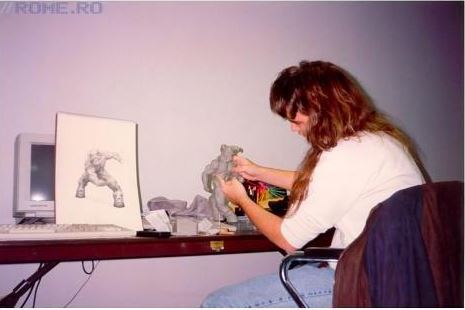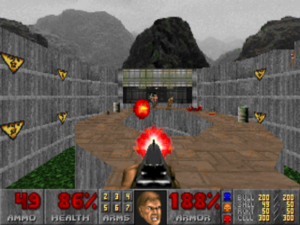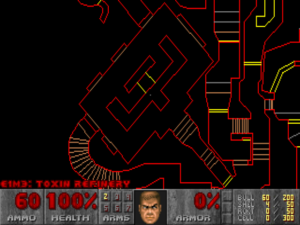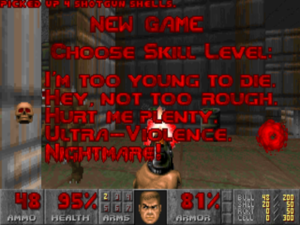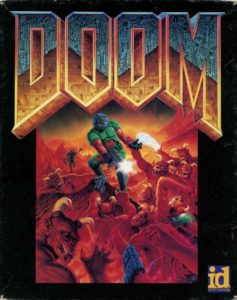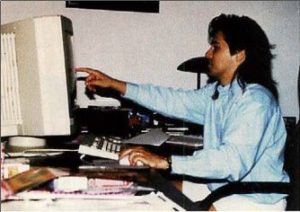Let me begin today by restating the obvious: DOOM was very, very popular, probably the most popular computer game to date.
That “probably” has to stand there because DOOM‘s unusual distribution model makes quantifying its popularity frustratingly difficult. It’s been estimated that id sold 2 to 3 million copies of the shareware episodes of the original DOOM. The boxed-retail-only DOOM II may have sold a similar quantity; it reportedly became the third best-selling boxed computer game of the 1990s. But these numbers, impressive as they are in their own right, leave out not only the ever-present reality of piracy but also the free episode of DOOM, which was packaged and distributed in such an unprecedented variety of ways all over the world. Players of it likely numbered well into the eight digits.
Yet if the precise numbers associated with the game’s success are slippery, the cultural impact of the game is easier to get a grip on. The release of DOOM marks the biggest single sea change in the history of computer gaming. It didn’t change gaming instantly, mind you — a contemporaneous observer could be forgiven for assuming it was still largely business as usual a year or even two years after DOOM‘s release — but it did change it forever.
I should admit here and now that I’m not entirely comfortable with the changes DOOM brought to gaming. In fact, for a long time, when I was asked when I thought I might bring this historical project to a conclusion, I pointed to the arrival of DOOM as perhaps the most logical place to hang it up. I trust that most of you will be pleased to hear that I no longer feel so inclined, but I do recognize that my feelings about DOOM are, at best, conflicted. I can’t help but see it as at least partially responsible for a certain coarsening in the culture of gaming that followed it. I can muster respect for the id boys’ accomplishment, but no love. Hopefully the former will be enough to give the game its due.
As the title of this article alludes, there are many possible narratives to spin about DOOM‘s impact. Sometimes the threads are contradictory — sometimes even self-contradictory. Nevertheless, let’s take this opportunity to follow a few of them to wherever they lead us as we wrap up this series on the shareware movement and the monster it spawned.
3D 4EVA!
The least controversial, most incontrovertible aspect of DOOM‘s impact is its influence on the technology of games. It was nothing less than the coming-out party for 3D graphics as a near-universal tool — this despite the fact that 3D graphics had been around in some genres, most notably vehicular simulations, almost as long as microcomputer games themselves had been around, and despite the fact that DOOM itself was far from a complete implementation of a 3D environment. (John Carmack wouldn’t get all the way to that goal until 1996’s Quake, the id boys’ anointed successor to DOOM.) As we’ve seen already, Blue Sky Productions’s Ultima Underworld actually offered the complete 3D implementation which DOOM lacked twenty months before the latter’s arrival.
But as I also noted earlier, Ultima Underworld was complex, a little esoteric, hard to come to terms with at first sight. DOOM, on the other hand, took what the id boys had started with Wolfenstein 3D, added just enough additional complexity to make it into a more satisfying game over the long haul, topped it off with superb level design that took full advantage of all the new affordances, and rammed it down the throat of the gaming mainstream with all the force of one of its coveted rocket launchers. The industry never looked back. By the end of the decade, it would be hard to find a big boxed game that didn’t use 3D graphics.
Many if not all of these applications of 3D were more than warranted: the simple fact is that 3D lets you do things in games that aren’t possible any other way. Other forms of graphics consist at bottom of fixed, discrete patterns of colored pixels. These patterns can be moved about the screen — think of the sprites in a classic 2D videogame, such as Nintendo’s Super Mario Bros. or id’s Commander Keen — but their forms cannot be altered with any great degree of flexibility. And this in turn limits the degree to which the world of a game can become an embodied, living place of emergent interactions; it does no good to simulate something in the world model if you can’t represent it on the player’s screen.
3D graphics, on the other hand, are stored not as pixels but as a sort of architectural plan of an imaginary 3D space, expressed in the language of mathematics. The computer then extrapolates from said plan to render the individual pixels on the fly in response to the player’s actions. In other words, the world and the representation of the world are stored as one in the computer’s memory. This means that things can happen there which no artist ever anticipated. 3D allowed game makers to move beyond hand-crafted fictions and set-piece puzzles to begin building virtual realities in earnest. Not for nothing did many people refer to DOOM-like games in the time before the term “first-person shooter” was invented as “virtual-reality games.”
Ironically, others showed more interest than the id boys themselves in probing the frontiers of formal possibility thus opened. While id continued to focus purely on ballistics and virtual violence in their extended series of Quake games after making DOOM, Looking Glass Technologies — the studio which had previously been known as Blue Sky Productions — worked many of the innovations of Ultima Underworld and DOOM alike into more complex virtual worlds in games like System Shock and Thief. Nevertheless, DOOM was the proof of concept, the game which demonstrated indubitably to everyone that 3D graphics could provide amazing experiences which weren’t possible any other way.
From the standpoint of the people making the games, 3D graphics had another massive advantage: they were also cheaper than the alternative. When DOOM first appeared in December of 1993, the industry was facing a budgetary catch-22 with no obvious solution. Hiring armies of artists to hand-paint every screen in a game was expensive; renting or building a sound stage, then hiring directors and camera people and dozens of actors to provide hours of full-motion-video footage was even more so. Players expected ever bigger, richer, longer games, which was intensely problematic when every single element in their worlds had to be drawn or filmed by hand. Sales were increasing at a steady clip by 1993, but they weren’t increasing quickly enough to offset the spiraling costs of production. Even major publishers like Sierra were beginning to post ugly losses on their bottom lines despite their increasing gross revenues.
3D graphics had the potential to fix all that, practically at a stroke. A 3D world is, almost by definition, a collection of interchangeable parts. Consider a simple item of furniture, like, say, a desk. In a 2D world, every desk must be laboriously hand-drawn by an artist in the same way that a traditional carpenter planes and joins the wood for such a thing in a workshop. But in a 3D world, the data constituting the basic form of “desk” can be inserted in a matter of seconds; desks can now make their way into games with the same alacrity with which they roll off of an IKEA production line. But you say that you don’t want every desk in your world to look exactly the same? Very well; it takes just a few keystrokes to change the color or wood grain or even the size of your desk, or to add or take away a drawer. We can arrive at endless individual implementations of “desk” from our Platonic ideal with surprising speed. Small wonder that, when the established industry was done marveling at DOOM‘s achievements in terms of gameplay, the thing they kept coming back to over and over was its astronomical profit margins. 3D graphics provided a way to make games make money again.
So, 3D offered worlds with vastly more emergent potential, made at a greatly reduced cost. There had to be a catch, right?
Alas, there was indeed. In many contexts, 3D graphics were right on the edge of what a typical computer could do at all in the mid-1990s, much less do with any sort of aesthetic appeal. Gamers would have to accept jagged edges, tearing textures, and a generalized visual crudity in 3D games for quite some time to come. A freeze-frame visual comparison with the games the industry had been making immediately before the 3D revolution did the new ones no favors: the games coming out of studios like Sierra and LucasArts had become genuinely beautiful by the early 1990s, thanks to those companies’ rooms full of dedicated pixel artists. It would take a considerable amount of time before 3D games would look anywhere near this nice. One can certainly argue that 3D was in some fairly fundamental sense necessary for the continuing evolution of game design, that this period of ugliness was one that the industry simply needed to plow through in order to emerge on the other side with a whole new universe of visual and emergent possibility to hand. Still, people mired in the middle of it could be forgiven for asking whether, from the evidence of screenshots alone, gaming technology wasn’t regressing rather than progressing.
But be that as it may, the 3D revolution ushered in by DOOM was here to stay. People would just have to get used to the visual crudity for the time being, and trust that eventually things would start to look better again.
Playing to the Base
There’s an eternal question in political and commercial marketing alike: do you play to the base, or do you try to reach out to a broader spectrum of people? The former may be safer, but raises the question of how many more followers you can collect from the same narrow slice of the population; the latter tempts you with the prospect of countless virgin souls waiting to embrace you, but is far riskier, with immense potential to backfire spectacularly if you don’t get the message and tone just right. This was the dichotomy confronting the boxed-games industry in the early 1990s.
By 1993, the conventional wisdom inside the industry had settled on the belief that outreach was the way forward. This dream of reaching a broader swath of people, of becoming as commonplace in living rooms as prime-time dramas and sitcoms, was inextricably bound up with the technology of CD-ROM, what with its potential to put footage of real human actors into games alongside spoken dialog and orchestral soundtracks. “What we think of today as a computer or a videogame system,” wrote Ken Williams of Sierra that year, “will someday assume a much broader role in our homes. I foresee a day when there is one home-entertainment device which combines the functions of a CD-audio player, VCR, videogame system, and computer.”
And then along came DOOM with its stereotypically adolescent-male orientation, along with sales numbers that threatened to turn the conventional wisdom about how well the industry could continue to feed off the same old demographic on its head. About six months after DOOM‘s release, when the powers that were were just beginning to grapple with its success and what it meant to each and every one of them, Alexander Antoniades, a founding editor of the new Game Developer magazine, more fully articulated the dream of outreach, as well as some of the doubts that were already beginning to plague it.
The potential of CD-ROM is tremendous because it is viewed as a superset not [a] subset of the existing computer-games industry. Everyone’s hoping that non-technical people who would never buy an Ultima, flight simulator, or DOOM will be willing to buy a CD-ROM game designed to appeal to a wider audience — changing the computer into [an] interactive VCR. If these technical neophytes’ first experience is a bad one, for $60 a disc, they’re not going to continue making the same mistake.
It will be this next year, as these consumers make their first CD-ROM purchases, that will determine the shape of the industry. If CD-ROM games are able to vary more in subject matter than traditional computer games, retain their platform independence, and capture new demographics, they will attain the status of a new platform [in themselves]. If not, they will just be another means to get product to market and will be just another label on the side of a box.
The next couple of years did indeed become a de-facto contest between these two ideas of gaming’s future. At first, the outreach camp could point to some notable successes on a scale similar to that of DOOM: The 7th Guest sold over 2 million copies, Myst sold an extraordinary 6 million or more. Yet the reality slowly dawned that most of those outside the traditional gaming demographic who purchased those games regarded them as little more than curiosities; most evidence would seem to indicate that they were never seriously played to a degree commensurate with their sales. Meanwhile the many similar titles which the industry rushed out in the wake of these success stories almost invariably became commercial disappointments.
The problems inherent in these multimedia-heavy “interactive movies” weren’t hard to see even at the time. In the same piece from which I quoted above, Alexander Antoniades noted that too many CD-ROM productions were “the equivalent of Pong games with captured video images of professional tennis players and CD-quality sounds of bouncing balls.” For various reasons — the limitations inherent in mixing and matching canned video clips; the core limitations of the software and hardware technology; perhaps simply a failure of imagination — the makers of too many of these extravaganzas never devised new modes of gameplay to complement their new modes of presentation. Instead they seemed to believe that the latter alone ought to be enough. Too often, these games fell back on rote set-piece puzzle-solving — an inherently niche activity even if done more creatively than we often saw in these games — for lack of any better ideas for making the “interactive” in interactive movies a reality. The proverbial everyday person firing up the computer-cum-stereo-cum-VCR at the end of a long workday wasn’t going to do so in order to watch a badly acted movie gated with frustrating logic puzzles.
While the multimedia came first with these productions, games of the DOOM school flipped that script. As the years went on and they too started to ship on the now-ubiquitous medium of CD-ROM, they too picked up cut scenes and spoken dialog, but they never suffered the identity crisis of their rivals; they knew that they were games first and foremost, and knew exactly what forms their interactivity should take. And most importantly from the point of view of the industry, these games sold. Post-1996 or so, high-concept interactive movies were out, as was most serious talk of outreach to new demographics. Visceral 3D action games were in, along with a doubling-down on the base.
To blame the industry’s retrenchment — its return to the demographically tried-and-true — entirely on DOOM is a stretch. Yet DOOM was a hugely important factor, standing as it did as a living proof of just how well the traditional core values of gaming could pay. The popularity of DOOM, combined with the exercise in diminishing commercial returns that interactive movies became, did much to push the industry down the path of retrenchment.
The minor tragedy in all this was not so much the end of interactive movies, given what intensely problematic endeavors they so clearly were, but rather that the latest games’ vision proved to be so circumscribed in terms of fiction, theme, and mechanics alike. By late in the decade, they had brought the boxed industry to a place of dismaying homogeneity; the values of the id boys had become the values of computer gaming writ large. Game fictions almost universally drew from the same shallow well of sci-fi action flicks and Dungeons & Dragons, with perhaps an occasional detour into military simulation. A shocking proportion of the new games being released fell into one of just two narrow gameplay genres: the first-person shooter and the real-time-strategy game.
These fictional and ludic genres are not, I hasten to note, illegitimate in themselves; I’ve enjoyed plenty of games in all of them. But one craves a little diversity, a more vibrant set of possibilities to choose from when wandering into one’s local software store. It would take a new outsider movement coupled with the rise of convenient digital distribution in the new millennium to finally make good on that early-1990s dream of making games for everyone. (How fitting that shaking loose the stranglehold of DOOM‘s progeny would require the exploitation of another alternative form of distribution, just as the id boys exploited the shareware model…)
The Murder Simulator
DOOM was mentioned occasionally in a vaguely disapproving way by mainstream media outlets immediately after its release, but largely escaped the ire of the politicians who were going after games like Night Trap and Mortal Kombat at the time; this was probably because its status as a computer rather than a console game led to its being played in bedrooms rather than living rooms, free from the prying eyes of concerned adults. It didn’t become the subject of a full-blown moral panic until weirdly late in its history.
On April 20, 1999, Eric Harris and Dylan Klebold, a pair of students at Columbine High School in the Colorado town of the same name, walked into their school armed to the teeth with knives, explosives, and automatic weapons. They proceeded to kill 13 students and teachers and to injure 24 more before turning their guns on themselves. The day after the massacre, an Internet gaming news site called Blue’s News posted a message that “several readers have written in reporting having seen televised news reports showing the DOOM logo on something visible through clear bags containing materials said to be related to the suspected shooters. There is no word yet of what connection anyone is drawing between these materials and this case.” The word would come soon enough.
It turned out that Harris and Klebold had been great devotees of the game, not only as players but as creators of their own levels. “It’s going to be just like DOOM,” wrote Harris in his diary just before the massacre. “I must not be sidetracked by my feelings of sympathy. I will force myself to believe that everyone is just a monster from DOOM.” He chose his prize shotgun because it looked like one found in the game. On the surveillance tapes that recorded the horror in real time, the weapons-festooned boys pranced and preened as if they were consciously imitating the game they loved so much. Weapons experts noted that they seemed to have adopted their approach to shooting from what worked in DOOM. (In this case, of course, that was a wonderful thing, in that it kept them from killing anywhere close to the number of people they might otherwise have with the armaments at their disposal.)
There followed a storm of controversy over videogame content, with DOOM and the genre it had spawned squarely at its center. Journalists turned their attention to the FPS subculture for the first time, and discovered that more recent games like Duke Nukem 3D — the Columbine shooters’ other favorite game, a creation of Scott Miller’s old Apogee Software, now trading under the name of 3D Realms — made DOOM‘s blood and gore look downright tame. Senator Joseph Lieberman, a longstanding critic of videogames, beat the drum for legislation, and the name of DOOM even crossed the lips of President Bill Clinton. “My hope,” he said, “[is] to persuade the nation’s top cultural producers to call a cease-fire in the virtual arms race, to stop the release of ultra-violent videogames such as DOOM. Several of the school gunmen murderously mimicked [it] down to the choice of weapons and apparel.”
When one digs into the subject, one can’t help but note how the early life stories of John Carmack and John Romero bear some eerie similarities with those of Eric Harris and Dylan Klebold. The two Johns as well were angry kids who found it hard to fit in with their peers, who engaged in petty crime and found solace in action movies, heavy-metal music, and computer games. Indeed, a big part of the appeal of DOOM for its most committed fans was the sense that it had been made by people just like them, people who were coming from the same place. What caused Harris and Klebold, alone among the millions like them, to exorcise their anger and aggression in such a horrifying way? It’s a question that we can’t begin to answer. We can only say that, unfair though it may be, perceptions of DOOM outside the insular subculture of FPS fandom must always bear the taint of its connection with a mass murder.
And yet the public controversy over DOOM and its progeny resulted in little concrete change in the end. Lieberman’s proposed legislation died on the vine after the industry fecklessly promised to do a better job with content warnings, and the newspaper pundits moved on to other outrages. Forget talk of free speech; there was too much money in these types of games for them to go away. Just ten months after Columbine, Activision released Soldier of Fortune, which made a selling point of dismembered bodies and screams of pain so realistic that one reviewer claimed they left his dog a nervous wreck cowering in a corner. After the requisite wave of condemnation, the mainstream media forgot about it too.
Violence in games didn’t begin with DOOM or even Wolfenstein 3D, but it was certainly amplified and glorified by those games and the subculture they wrought. While a player may very well run up a huge body count in, say, a classic arcade game or an old-school CRPG, the violence there is so abstract as to be little more than a game mechanic. But in DOOM — and even more so in the games that followed it — experiential violence is a core part of the appeal. One revels in killing not just because of the new high score or character experience level one gets out of it, but for the thrill of killing itself, as depicted in such a visceral, embodied way. This does strike me as a fundamental qualitative shift from most of the games that came before.
Yet it’s very difficult to have a reasonable discussion on said violence’s implications, simply because opinions have become so hardened on the subject. To express concern on any level is to invite association with the likes of Joe Lieberman, a thoroughly conventional thinker with a knack for embracing the most flawed of all conventional wisdoms on every single issue, who apparently was never fortunate enough to have a social-science professor drill the fact that correlation isn’t causation into his head.
Make no mistake: the gamers who scoff at the politicians’ hand-wringing have a point. Harris and Klebold probably were drawn to games like DOOM and Duke Nukem 3D because they already had violent fantasies, rather than having said fantasies inculcated by the games they happened to play. In a best-case scenario, we can even imagine other potential mass murderers channeling their aggression into a game rather than taking it out on real people, in much the same way that easy access to pornography may be a cause of the dramatic decline in incidents of rape and sexual violence in most Western countries since the rise of the World Wide Web.
That said, I for one am also willing to entertain the notion that spending hours every day killing things in the most brutal, visceral manner imaginable inside an embodied virtual space may have some negative effects on some personalities. Something John Carmack said about the subject in a fairly recent interview strikes me as alarmingly fallacious:
In later games and later times, when games [came complete with] moral ambiguity or actual negativity about what you’re doing, I always felt good about the decision that in DOOM, you’re fighting demons. There’s no gray area here. It is black and white. You’re the good guys, they’re the bad guys, and everything that you’re doing to them is fully deserved.
In reality, though, the danger which games like DOOM may present, especially in the polarized societies many of us live in in our current troubled times, is not that they ask us to revel in our moral ambiguity, much less our pure evil. It’s rather the way they’re able to convince us that the Others whom we’re killing “fully deserve” the violence we visit upon them because “they’re the bad guys.” (Recall those chilling words from Eric Harris’s diary, about convincing himself that his teachers and classmates are really just monsters…) This tendency is arguably less insidious when the bad guys in question are ridiculously over-the-top demons from Hell than when they’re soldiers who just happen to be wearing a different uniform, one which they may quite possibly have had no other choice but to don. Nevertheless, DOOM started something which games like the interminable Call of Duty franchise were only too happy to run with.
I personally would like to see less violence rather than more in games, all things being equal, and would like to see more games about building things up rather than tearing them down, fun though the latter can be on occasion. It strikes me that the disturbing association of some strands of gamer culture with some of the more hateful political movements of our times may not be entirely accidental, and that some of the root causes may stretch all the way back to DOOM — which is not to say that it’s wrong for any given individual to play DOOM or even Call of Duty. It’s only to say that the likes of GamerGate may be yet another weirdly attenuated part of DOOM‘s endlessly multi-faceted legacy.
Creative Destruction?
In other ways, though, the DOOM community actually was — and is — a community of creation rather than destruction. (I did say these narratives of DOOM wouldn’t be cut-and-dried, didn’t I?)
John Carmack, by his own account alone among the id boys, was inspired rather than dismayed by the modding scene that sprang up around Wolfenstein 3D — so much so that, rather than taking steps to make such things more difficult in DOOM, he did just the opposite: he separated the level data from the game engine much more completely than had been the case with Wolfenstein 3D, thus making it possible to distribute new DOOM levels completely legally, and released documentation of the WAD format in which the levels were stored on the same day that id released the game itself.
The origins of his generosity hearken back once again to this idea that the people who made DOOM weren’t so very different from the people who played it. One of Carmack’s formative experiences as a hacker was his exploration of Ultima II on his first Apple II. Carmack:
To go ahead and hack things to turn trees into chests or modify my gold or whatever… I loved that. The ability to go several steps further and release actual source code, make it easy to modify things, to let future generations get what I wished I had had a decade earlier—I think that’s been a really good thing. To this day I run into people all the time that say, whether it was Doom, or maybe even more so Quake later on, that that openness and that ability to get into the guts of things was what got them into the industry or into technology. A lot of people who are really significant people in significant places still have good things to say about that.
Carmack speaks of “a decade-long fight inside id about how open we should be with the technology and the modifiability.” The others questioned this commitment to what Carmack called “open gaming” more skeptically than ever when some companies started scooping up some of the thousands of fan-made levels, plopping them onto CDs, and selling them without paying a cent to id. But in the long run, the commitment to openness kept DOOM alive; rather than a mere computer game, it became a veritable cottage industry of its own. Plenty of people played literally nothing else for months or even years at a stretch.
The debate inside id raged more than ever in 1997, when Carmack insisted on releasing the complete original source code to DOOM. (He had done the same for the Wolfenstein 3D code two years before.) As he alludes above, the DOOM code became a touchstone for an up-and-coming generation of game programmers, even as many future game designers cut their teeth and made early names for themselves by creating custom levels to run within the engine. And, inevitably, the release of the source code led to a flurry of ports to every imaginable platform: “Everything that has a 32-bit [or better] processor has had DOOM run on it,” says Carmack with justifiable pride. Today you can play DOOM on digital cameras, printers, and even thermostats, and do so if you like in hobbyist-created levels that coax the engine into entirely new modes of play that the id boys never even began to conceive of.
This narrative of DOOM bears a distinct similarity to that of another community of creation with which I happen to be much better acquainted: the post-Infocom interactive-fiction community that arose at about the same time that the original DOOM was taking the world by storm. Like the DOOM people, the interactive-fiction people built upon a beloved company’s well-nigh timeless software engineering; like them, they eventually stretched that engine in all sorts of unanticipated directions, and are still doing it to this day. A comparison between the cerebral text adventures of Infocom and the frenetic shooters of id might seem incongruous at first blush, but there you are. Long may their separate communities of love and craft continue to thrive.
As you have doubtless gathered by now, the legacy of DOOM is a complicated one that’s almost uniquely resistant to simplification. Every statement has a qualifier; every yang has a yin. This can be frustrating for a writer; it’s in the nature of us as a breed to want straightforward causes and effects. The desire for them may lead one to make trends that were obscure at best to the people living through them seem more obvious than they really were. Therefore allow me to reiterate that the new gaming order which DOOM created wouldn’t become undeniable to everyone until fully three or four years after its release. A reader recently emailed me the argument that 1996 was actually the best year ever for adventure games, the genre which, according to some oversimplified histories, DOOM and games like it killed at a stroke — and darned if he didn’t make a pretty good case for it.
So, while I’m afraid I’ll never be much of a gibber and/or fragger, we should continue to have much to talk about. Onward, then, into the new order. I dare say that from the perspective of the boots on the ground it will continue to look much like the old one for quite some time to come. And after that? Well, we’ll take it as it comes. I won’t be mooting any more stopping dates.
(Sources: the books The Complete Wargames Handbook (2000 edition) by James F. Dunnigan, Masters of Doom by David Kushner, Game Engine Black Book: DOOM by Fabien Sanglard, Principles of Three-Dimensional Computer Animation by Michael O’Rourke, and Columbine by Dave Cullen; Retro Gamer 75; Game Developer of June 1994; Chris Kohler’s interview with John Carmack for Wired. And a special thanks to Alex Sarosi, a.k.a. Lt. Nitpicker, for his valuable email correspondence on the legacy of DOOM, as well as to Josh Martin for pointing out in a timely comment to the last article the delightful fact that DOOM can now be run on a thermostat.)



